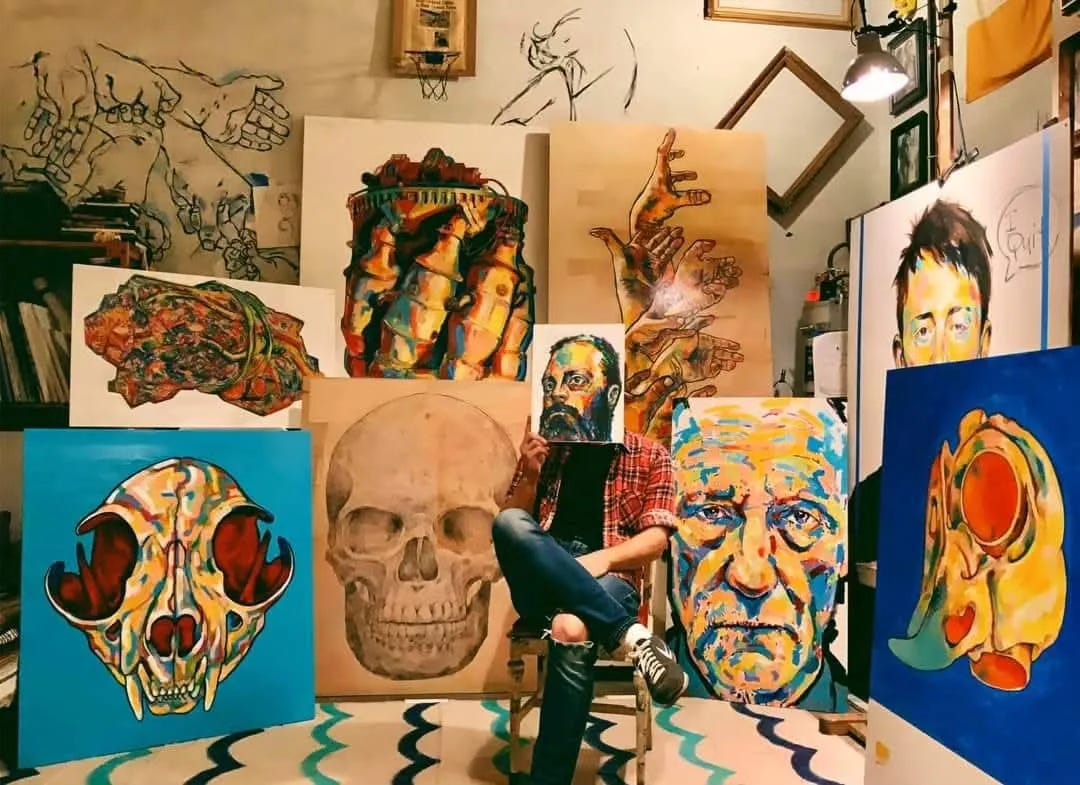In a strange and tragic follow up to my previous post, I was first introduced to Val Kilmer over 10 years ago by Harmony Korine. Val and Harmony were collaborating on a short film and we had the occasion to have dinner together in Los Angeles. During that conversation, Val informed me that in addition to his work as an actor, he was also a visual artist and he invited me to his house to see what he was working on. Upon my arrival to, what I must say, was a very humble home near Brentwood, I felt like I was entering the mind of a truly visionary artist. There were sculptures, paintings, collages and other strange assemblages displayed throughout the house. This meeting began a friendship that lasted over many years. I was editing an arts magazine called ANP Quarterly at the time and we published a portfolio of his collages and every so often we would get together to speak about art. Not only his, but the works of other artists as well. We also spoke of his challenges with being taken seriously as a visual artist because he was so well known as an actor. At one point Val was working on a coffee table book of his artworks and asked me to write an essay for it. The piece was never published. In fact, Val hated it. It actually caused a small rift in our relationship. I decided to include it below (sorry Val!) as I feel like it fits into the concept of Confessions Of A Polymath. In life, people prefer you to be just one thing. It’s something Val struggled with as a visual artist and something that I can relate to as well. Being not easily categorized is both a blessing and a curse.
Val Kilmer passed away last week at the age of 65. He will be missed.
The story of art is littered with preposterous narratives. One could venture to say, that the more academics have tried to figure out exactly what makes art “great”, the more their didactions are almost always completely incorrect. This is of course why the understanding of the artistic process has continued to bewilder our society, but also what makes the whole adventure so wonderfully enjoyable. The visual works of Val Kilmer fit neatly into this conundrum. It cannot be denied that Kilmer is widely recognized as an actor, and as the result of this, his oeuvre in this medium has undoubtedly been emblazoned into our collective psyche. However, those achievements have been based on Kilmer’s ability to interpret other artists’ characters, and he is most certainly a master of this. What sets apart his works in the realm of visual art is another story completely. Here we don’t meet Val Kilmer the actor. We are instead introduced to a man as himself…an emotional nascent being maneuvering through the struggles of the soul as any other working artist would attempt.
Kilmer’s visual practice is diverse, ranging from paintings, photography, print-making, sculptures and works of collage. Sometimes figurative and other times abstract. While at first glance this approach may seem somewhat schizophrenic, with a closer look it’s easily understood that there is a continuing narrative throughout. The roots of these works exist in beautifully constructed scrapbooks created by the artist as one-of-a-kind editions. Painstakingly crafted and layered with drawings, ephemera, photography and collage, they tell the story of an artist’s life. Delving at times into his work in the movies, but more often than not exploring greater themes dealing with the understanding of the human condition. In fact, it’s entirely possible that as the result of Kilmer’s long history of playing narrative roles, he brings a completely unique approach to the realm of visual art. After all, what is the primary duty of an artist? Isn’t it to interpret the world in creative ways so that we as a society can have a better understanding of who we are?
If broken down, the creative process is essentially the same across mediums. All great art starts with a sketch…in Kilmer’s instance, a scrapbook. The sketch is then expanded, revised and edited into various forms until a solid through-line exists that delivers a message in the most powerful way possible. If we look at Kilmer’s work through this lens, then we start to understand that the old saying, “Jack of all trades, master of none” is an outdated trope. An artist’s experience is his and his alone. All of the experience a particular creator brings to the table is what makes his or her voice unique. Val Kilmer’s work most certainly checks all those boxes. Like all great artists, Kilmer looks at the world through a kaleidoscopic field. Opportunities to interpret this cornucopia come to him naturally and without pretense. His effort is real. His vision is pure.





